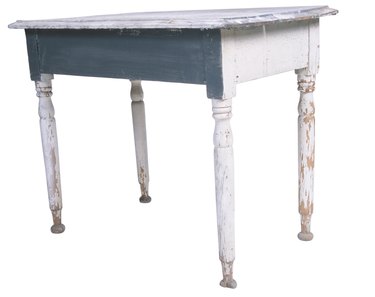
Some call it shabby chic. Others refer to it as distressed antiquing. Both refer to a method of painting furniture to look old and worn. Distressed painting is simple method of painting you can do yourself at home. Turquoise distressed painting can blend with current room colors while giving a retro, lived-in appeal look to any room in your home.
Preparation and First Coat
Video of the Day
Prepare your piece for painting. Sand over the piece to roughen it so that the primer will adhere well. If you want your piece to appear extremely distressed, hit the piece with something that will produce nicks, or gouge it with a knife or screwdriver to give it a slightly abused look. Use the correct type of primer for the surface you are painting. This is the layer that will be showing through the distressed areas. Whether you use a different shade of turquoise for the undercoat and the top coat or a completely different color is a matter of preference. A contrasting color will give more dramatic results.
Video of the Day
Making Distressed Areas
Rub areas you want to distress with wax. Areas that take abuse such as corners, drawer handles and edges are good places to distress for a natural look. Try distressing that looks like areas of paint were washed off. Achieve this look by heating some wax and dipping a thin bristled brush in the wax then pressing the bristles into an area or two on the piece. Once you have distressed the item, apply the top coat of paint.
Distressing
Apply your top coat and let the piece dry thoroughly before distressing. Once the paint dries, remove the areas you coated to distress the piece. Use a dull knife such as a butter or cheese knife to scrap the areas you coated with wax. The knife will chip away the paint. Use a piece of sandpaper to lightly smooth the chipped edges of the paint. Also use sandpaper to distress more areas down to the primer coat once you see your results. Be careful not to put too much pressure on the sandpaper or you may remove the primer coat, too.
Antiquing
Once your piece is distressed, add the finishing antique touch. Use a medium brown paint for the antiquing to give the piece a naturally aged look. Dilute the paint with water until it is thin and runny. Apply the thinned paint to a small area then wipe it off with a lint-free cloth. Reapply paint if you wipe too much off. Let your beautiful turquoise show through unmarred in some areas. Once you are sure your piece has dried, apply a varnish sealant to protect your turquoise finish and all of the beautiful destruction you have achieved.